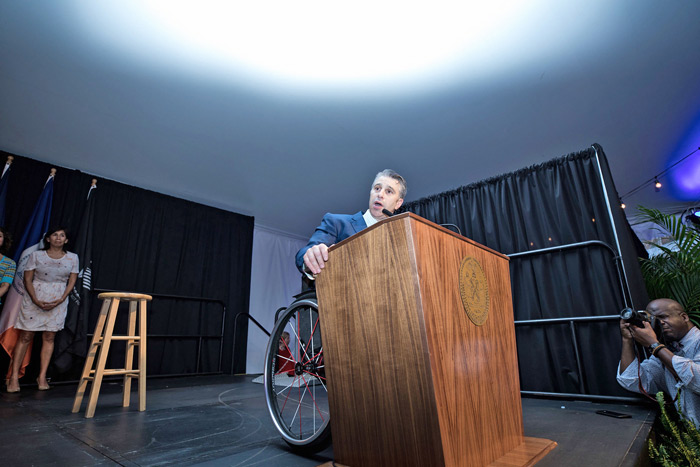Photo Courtesy of Benjamin Kanter/Mayoral Photography Office
“In order to lower the unemployment rate for people with disabilities we need to change the culture in the workplace,” said Victor Calise, commissioner of the Mayor’s Office for People with Disabilities.
By Forum Staff
People with disabilities in the five boroughs face higher rates of unemployment, poverty, and lower earnings than those without disabilities, according to a report released Thursday by State Comptroller Tom DiNapoli.
According to the report, which is based on U.S. Census figures from 2017 and indicates that there were 930,100 people with disabilities residing in the city that year, representing 11 percent of the total population, the unemployment rate for people with disabilities living in the five boroughs fell to 14.7 percent by 2017, but it was far higher than for those without disabilities (6 percent). African-Americans (18.9 percent) and Hispanics (15.3 percent) with disabilities had higher unemployment rates than whites (14.3 percent) and Asians (13.4 percent). A larger share of individuals with disabilities were employed part-time (36 percent) compared to those without disabilities (27 percent). Workers with disabilities also earned 20 percent less, the report indicates.
“There is a stark disparity in employment rates and wages for people with disabilities,” said DiNapoli. “A recent study shows that when businesses embrace disability inclusion, it benefits the corporation and its shareholders. There are some positive signs that companies are opening up jobs to people with disabilities, but more needs to be done to get employers to recognize that inclusion is a smart business decision. Fortunately, New York City is moving in the right direction with progressive leadership on this important issue.”
DiNapoli’s analysis also found:
- In 2017, 65 percent of people with disabilities in the five boroughs between the ages of 18 and 64 were either unemployed or not actively seeking employment. The share rises to 79 percent for those age 16 and over.
- Of the 259,400 working-age city residents with disabilities not in the labor force (i.e., unemployed and not actively seeking employment), nearly two-thirds had at least a high school diploma, with one-third having at least some college experience.
- The median earnings for residents with disabilities was $32,000 in 2017, 20-percent less than those without disabilities.
- Overall, 34 percent of working age residents with disabilities had incomes below the federal poverty level, more than twice the share for those without disabilities (14 percent).
- The U.S. Census Bureau has begun to release data for 2018, which indicates that the number of people with disabilities with jobs declined in 2018 after increasing in the two prior years.
“In order to lower the unemployment rate for people with disabilities we need to change the culture in the workplace,” said Victor Calise, Ozone Park native and commissioner of the Mayor’s Office for People with Disabilities. “Businesses need to understand the benefits of hiring people with disabilities and the barriers that they face to employment. Job seekers with disabilities need the opportunity to demonstrate their value to employers and understand how to navigate the unique challenges they face. Through MOPD’s employment initiative, NYC: ATWORK, we work with both sides to increase their connections and move the needle on the unemployment rate for people with disabilities.”

